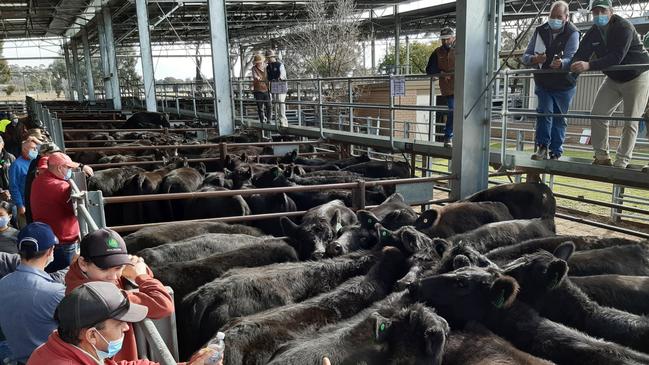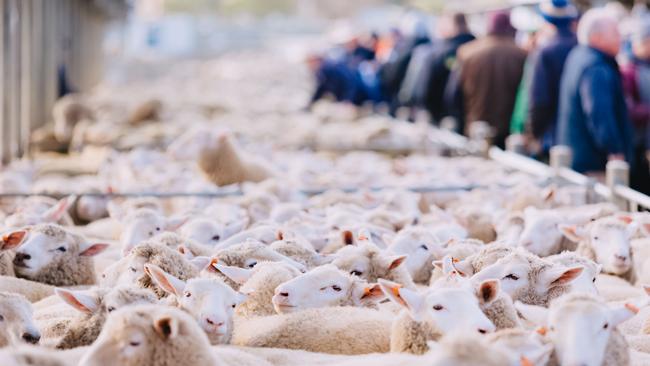Young cattle climb to new high while lamb prices post gains
Pressure remains on cattle buyers, led by another surge in restocking demand, while lamb rates were also positive.

Wet weather and a public holiday have combined to keep pressure on cattle buyers, culminating in a new price record for the Eastern Young Cattle Indicator in the past week.
Restocking demand out of Queensland and NSW was the driver for the EYCI pushing back over 900c/kg carcass weight, hitting a record 913c/kg last Thursday.
The day this record was set, a breakdown of the data shows the price point for vealers and yearlings sold back to the paddock was a high 981c/kg, compared with feedlots paying an average of 869c/kg and processors behind this at 828c/kg.
Much of the big money paid for young cattle was at saleyards across NSW and into Queensland, with centres such as Scone, Singleton, Casino, Roma and Wagga Wagga all posting results well over 900c/kg.
All the Victorian saleyards that feed into the EYCI were tracking under 900c/kg. The highest on the list was Shepparton at 886c/kg.
In liveweight terms, young calves selling to restockers have mostly been in the range of 450-550c/kg. On Thursday last week 778 yearling steers were sold to the paddock at an average of 484c/kg or $1419 a head over an average weight of 297kg. This was 6c/kg higher than the previous week, according to the National Livestock Reporting Service.
The 814 yearling steers that sold to feedlots averaged 444c/kg liveweight or $1696 over a weight of 383kg, for a slight fall of 4c/kg. Processors remained quiet, buying only 104 yearling steers at an average cost of 465c/kg for 412kg at $1923.
By volume, it was a big week for cows, which have been accounting for a big percentage of yardings at many centres. A case in point was Leongatha last week where cows made up more than half of the 1498 offering.
Market reports show cow sales have been consistently strong, average results only varying by a few cents a kilogram each day.
Last Thursday the NLRS assessed 3093 cows at saleyards for an overall result of 285c/kg liveweight over all breeds and weights.
When the data is analysed it shows heavier beef cows to processors making up to 335c/kg and averaging 295c/kg or $1664 on a weight of 557kg. Plainer dairy cows averaged 253c/kg or $1404 on a weight of 544kg.
Supplies of grown steers remain tight, but prices stagnated between 360c/kg and 410c/kg for most, depending on quality and size. The average for 1551 grown steers sold last Thursday was 375c/kg or $1885 on a weight of 503kg.
SHORT WEEK ADDS SOME FAT TO LAMB PRICES
Rain and a disrupted trading week due to the long weekend helped put the lamb market on a dearer trend late last week.
The Wagga Wagga sale, held last Thursday in NSW and the biggest weekly market in the eastern states, posted some strong gains as supplies were cut to 25,900 by the wet weather.
Prices for good trade and export lambs lifted $10 to $16, according to the National Livestock Reporting Service, carrying some super-sized lambs to a top of $310.
On a carcass basis, quality trade lambs in the ideal size range of 22-24kg made from $191 to $224 to average $211 at an estimated 882c/kg carcass weight. The heavier trades, 24-26kg, sold from $206 to $226 to average $217 or 854c/kg.
Those carcass prices are some of the best quoted out of the auction system in recent weeks, but it remains unclear whether it was a temporary spike due to a shortage of numbers or a rising trend going into winter.
Looking at the bigger picture, price data still shows most crossbred lambs trading from 750c/kg to 820c/kg in the past week.
At the close of trading last week the saleyard indicator for heavy lamb was at 806c/kg, and trade lambs at 814c/kg. The Merino average was at 741c/kg. The trend for those categories was slightly dearer than the previous week.
However, the market still has a long way to go to catch up to the price points that farmers were receiving last winter. Prime lambs are tracking 60c/kg to 100c/kg behind what they were getting last June.

While numbers should tighten as we head deeper into winter, it is also a period when major exporters shut down for maintenance which could balance out supply and demand.
The mutton market has been the most resilient category, listed at 646c/kg to be just 40c/kg shy of last June.
The strong outcome is linked to supply, with the latest kill figures showing sheep production for the first week of June still at a low 85,476.
In comparison, slaughter data shows lamb supplies are still tracking at solid levels.
Meat and Livestock Australia reported a lamb kill of 389,953 for the first week of this month, which is 40,000 above year ago levels and much higher than the early winter of 2019 when it dropped to 282,456.
MORE
AUSSIE SHEEP FLOCK SET TO INCREASE, AS PRODUCERS REBUILD


